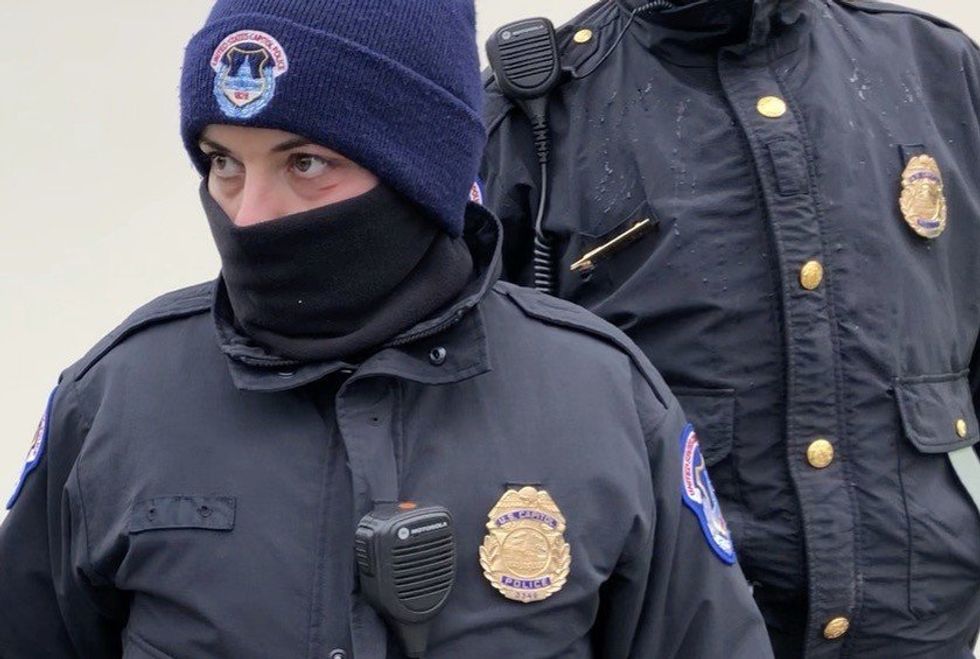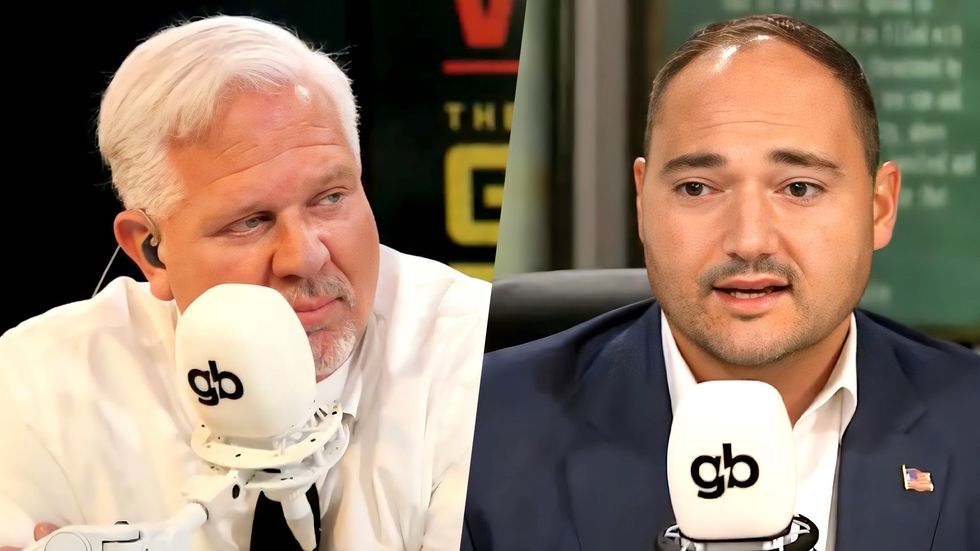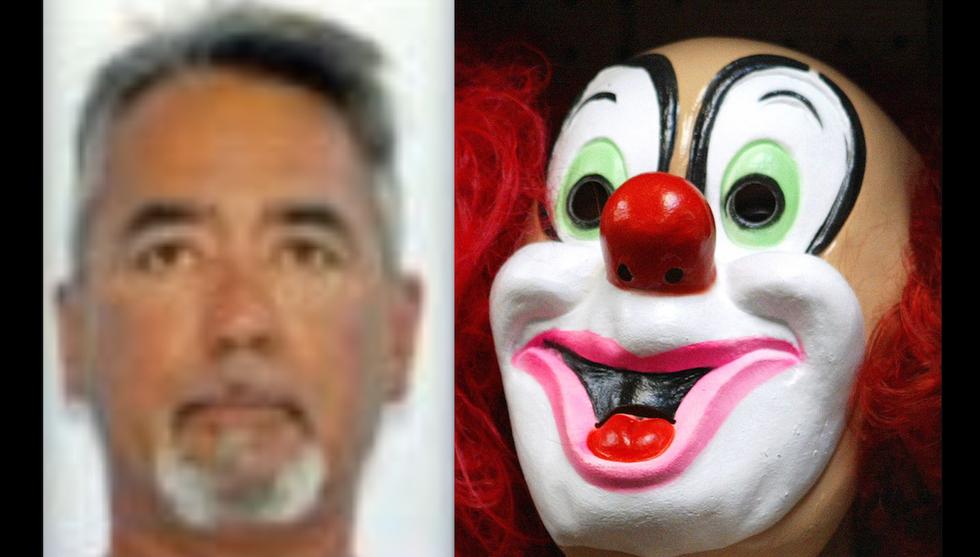Capitol Police were sacrificial pawns on Jan. 6: ‘They didn’t give a s**t about what happened’
In preparation for the first installment of Blaze Media’s three-part mini-documentary series, “A Day in the Life of Harry Dunn,” we decided to update readers on how we reached this point in our “Truth About January 6” series. I had been writing about January 6 for nearly two and a half years before becoming a correspondent with Blaze Media. As a result, many of our readers may be unfamiliar with the background stories that led to our major revelations about the trial perjuries of Capitol Police Special Agent David Lazarus and Officer Harry Dunn. Our reports also exposed corruption within the leadership of the United States Capitol Police. My interest in the Capitol Police began when I first witnessed the violence on the lower west terrace of the Capitol Building on January 6. Through my camera lens, I captured the fear in their eyes — not just from the attacks by a small group of violent provocateurs but from the overwhelming sight of thousands of protesters advancing on their position. The police were clearly caught off guard. But why? Were they unaware of the scheduled marches and legally permitted protests on the Capitol grounds that day? I needed to find the answers to these questions, and that curiosity sparked what has now become a three-and-a-half-year investigation into the inner workings of the Capitol Police. No ordinary day When I first met former Capitol Police Lieutenant Tarik Johnson, I told him that I had previously written about how he and his fellow officers were set up as “sacrificial pawns” on January 6. He pointed his finger at me and said, “That’s exactly right. They didn’t give a s**t about what happened to us that day.” Now, imagine being a Capitol Police officer showing up to work on January 6, 2021, expecting a normal day at the office. Whether you were a rookie or had 20 years of experience with the agency — regardless of your specialized training and position — many officers had spent years performing what amounted to the duties of a glorified tour guide for VIP visitors and general tourists at the nation’s seat of government. That’s an oversimplification, as the Capitol Police are made up of various specialized units, including long-gun-certified officers, a civil disturbance unit, the criminal investigation squad, the intelligence unit, dignitary protection, a SWAT team, the hazardous devices team, and several others. Why didn’t the Capitol Police frontline officers know what was coming their way? Skipping ahead to the initial breach of the west-side barricades — where Capitol Police Officer Caroline Edwards was knocked unconscious after being shoved down by the first violent perpetrators, hitting her head on the concrete steps — now imagine being one of the few dozen Capitol Police officers ordered to respond, redeploy, and defend the Capitol’s lower west terrace against the initial agitators and provocateurs. Many supposed protesters arrived wearing gas masks, carrying blunt instruments, and holding canisters of various types of pepper spray. And who knows what else might have been concealed under their thick winter clothing? You’ve heard over Capitol Police radio that unexpected visitors have already overrun outer barricades. They’re now pushing and pulling against the barricade line you just arrived to defend. Some rioters are breaking apart permanent black-metal fencing, turning the pieces into clubs and projectile spears. You’ve arrived on the battle line without protective gear — no helmet, eye protection, or gas mask. Still, your job is to prevent further incursion toward the Capitol Building, where Congress and the vice president of the United States are currently in session to certify the Electoral College vote. Already outnumbered by both peaceful protesters and violent agitators, you look over the crowd and see thousands more protesters marching toward your position, their intentions unknown. As you defend the third, hastily assembled bike rack barricade line, you're being shoved, hit with flagpoles and broken pieces of fencing, and assaulted with pepper spray. You have no idea whether the thousands approaching your position also intend violence or carry more dangerous weapons. You might rightly assume you may never go home to your family again. Tarik Johnson told me exactly that. During the initial chaos and violence on January 6, Johnson called his wife to say he might not make it home alive. Video verification Two years later, many of my initial impressions were challenged by new and increasingly available evidence. For example, on the evening of Jan. 6, after returning to my Arlington, Virginia, hotel room, I posted a video on YouTube during which I said I had witnessed the majority of the violence being committed by Trump supporters. After returning home, I spent five days conducting a frame-by-frame analysis of my own footage, taken from the Capitol’s west terrace battle line and through the Capitol building. D


In preparation for the first installment of Blaze Media’s three-part mini-documentary series, “A Day in the Life of Harry Dunn,” we decided to update readers on how we reached this point in our “Truth About January 6” series.
I had been writing about January 6 for nearly two and a half years before becoming a correspondent with Blaze Media. As a result, many of our readers may be unfamiliar with the background stories that led to our major revelations about the trial perjuries of Capitol Police Special Agent David Lazarus and Officer Harry Dunn. Our reports also exposed corruption within the leadership of the United States Capitol Police.
My interest in the Capitol Police began when I first witnessed the violence on the lower west terrace of the Capitol Building on January 6. Through my camera lens, I captured the fear in their eyes — not just from the attacks by a small group of violent provocateurs but from the overwhelming sight of thousands of protesters advancing on their position. The police were clearly caught off guard.
But why? Were they unaware of the scheduled marches and legally permitted protests on the Capitol grounds that day?
I needed to find the answers to these questions, and that curiosity sparked what has now become a three-and-a-half-year investigation into the inner workings of the Capitol Police.
No ordinary day
When I first met former Capitol Police Lieutenant Tarik Johnson, I told him that I had previously written about how he and his fellow officers were set up as “sacrificial pawns” on January 6. He pointed his finger at me and said, “That’s exactly right. They didn’t give a s**t about what happened to us that day.”
Now, imagine being a Capitol Police officer showing up to work on January 6, 2021, expecting a normal day at the office. Whether you were a rookie or had 20 years of experience with the agency — regardless of your specialized training and position — many officers had spent years performing what amounted to the duties of a glorified tour guide for VIP visitors and general tourists at the nation’s seat of government.
That’s an oversimplification, as the Capitol Police are made up of various specialized units, including long-gun-certified officers, a civil disturbance unit, the criminal investigation squad, the intelligence unit, dignitary protection, a SWAT team, the hazardous devices team, and several others.
Why didn’t the Capitol Police frontline officers know what was coming their way?
Skipping ahead to the initial breach of the west-side barricades — where Capitol Police Officer Caroline Edwards was knocked unconscious after being shoved down by the first violent perpetrators, hitting her head on the concrete steps — now imagine being one of the few dozen Capitol Police officers ordered to respond, redeploy, and defend the Capitol’s lower west terrace against the initial agitators and provocateurs. Many supposed protesters arrived wearing gas masks, carrying blunt instruments, and holding canisters of various types of pepper spray. And who knows what else might have been concealed under their thick winter clothing?
You’ve heard over Capitol Police radio that unexpected visitors have already overrun outer barricades. They’re now pushing and pulling against the barricade line you just arrived to defend. Some rioters are breaking apart permanent black-metal fencing, turning the pieces into clubs and projectile spears.
You’ve arrived on the battle line without protective gear — no helmet, eye protection, or gas mask. Still, your job is to prevent further incursion toward the Capitol Building, where Congress and the vice president of the United States are currently in session to certify the Electoral College vote.
Already outnumbered by both peaceful protesters and violent agitators, you look over the crowd and see thousands more protesters marching toward your position, their intentions unknown.
As you defend the third, hastily assembled bike rack barricade line, you're being shoved, hit with flagpoles and broken pieces of fencing, and assaulted with pepper spray. You have no idea whether the thousands approaching your position also intend violence or carry more dangerous weapons.
You might rightly assume you may never go home to your family again. Tarik Johnson told me exactly that. During the initial chaos and violence on January 6, Johnson called his wife to say he might not make it home alive.
Video verification
Two years later, many of my initial impressions were challenged by new and increasingly available evidence. For example, on the evening of Jan. 6, after returning to my Arlington, Virginia, hotel room, I posted a video on YouTube during which I said I had witnessed the majority of the violence being committed by Trump supporters. After returning home, I spent five days conducting a frame-by-frame analysis of my own footage, taken from the Capitol’s west terrace battle line and through the Capitol building.
During that video review, I repeatedly found myself asking, “Who is that?”
By the time I published my first story about what I witnessed that day, all my initial preconceptions were challenged. I even adopted a new life rule: “I’ll never again believe anything I don't see with my own eyes ... but even then, consult the videotape.”
Our eyes can deceive us during a chaotic, violent event. That's why every law enforcement officer knows that a dozen eyewitnesses to a violent crime will give a dozen different accounts of what happened. Without ample experience in such events, the shock of unexpected violence makes people's minds register and process the episode in various and often contradictory ways.
I now know — beyond a reasonable doubt — that some of those frontline agitators and provocateurs, who I initially assumed were all Trump supporters, were anything but.
Right-wing militias were present. Left-wing anarchists and Antifa? Possibly. I definitely observed crowd manipulation tactics from professional provocateurs experienced in inciting violence and coordinating the movements of large groups.
Do I know for certain whom these provocateurs worked for? Not entirely, but our understanding is growing.
Secret commandos on scene
Senate Sergeant-at-Arms Michael Stenger, in his final testimony before Congress on February 23, 2021, stated: “There is an opportunity to learn lessons from the events of January 6. Investigations should be considered as to funding and travel of what appears to be professional agitators.”
During the January 2023 trial of Richard “Bigo” Barnett, who posed with his feet on Nancy Pelosi’s desk, defense attorney Bradford Geyer directly asked Capitol Police Captain Carneysha Mendoza whether the provocateurs she observed on January 6 operated as “highly trained violent people who work and coordinate together.” Mendoza confirmed, “Yes.”
In the lead-up to my second story about January 6 — published on February 24, 2021 — my investigations led me to discover and report that several federal agencies, including Army special forces operatives, were embedded in the crowd that day. This was later confirmed by a Newsweek story on January 3, 2022, headlined “Secret Commandos with Shoot-to-Kill Authority Were at the Capitol.”
Newsweek revealed that the mission of those tactical units from virtually every three-letter federal agency, along with “the role that the military played in this highly classified operation,” is “still unknown.” Yet those special operators and tactical forces were “seconded” to the FBI.
If the FBI had advance intelligence substantial enough to warrant deploying such a highly trained and well-armed secret force, why didn’t the Capitol Police frontline officers also know what was coming their way?
Or did only certain individuals within the Capitol Police leadership know what was coming that day?
Originally Published at Daily Wire, World Net Daily, or The Blaze
What's Your Reaction?
































































































